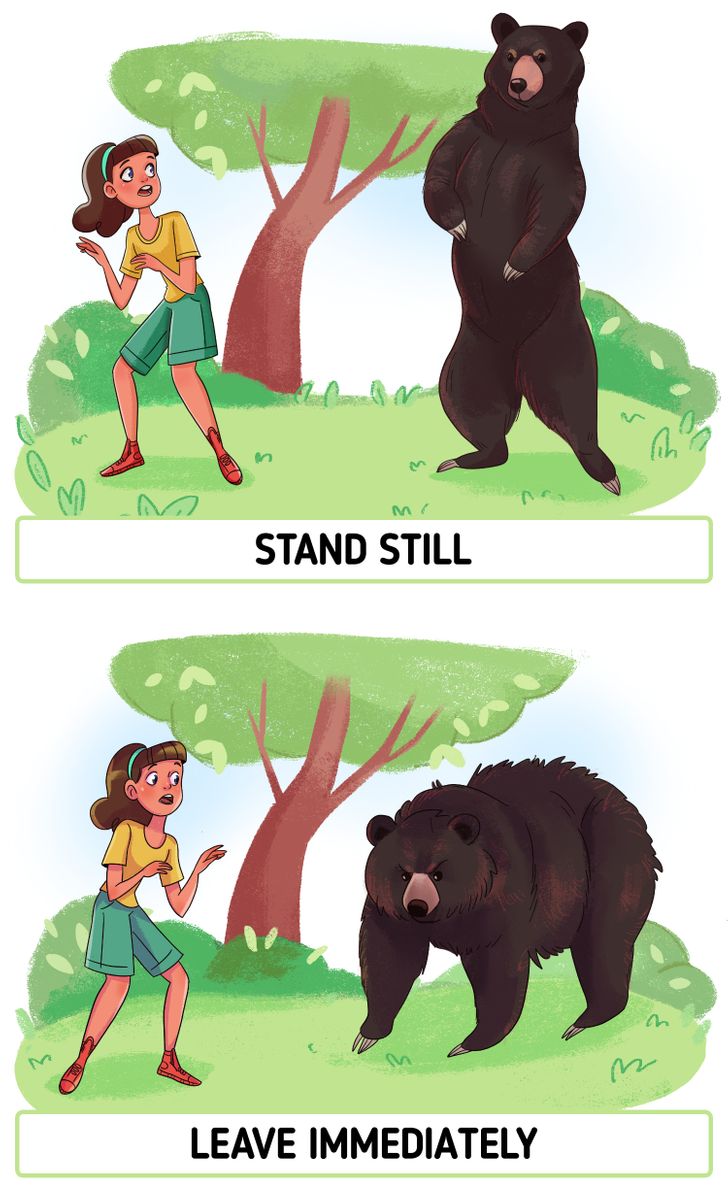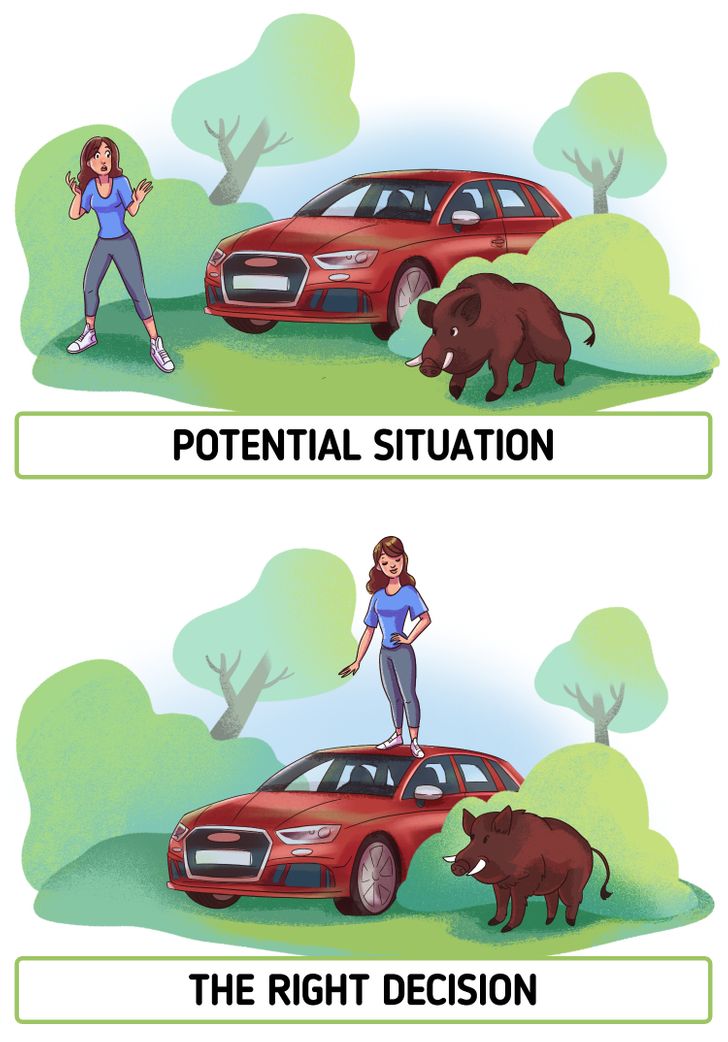Hey Thanks
How to Stay Safe If You Find Yourself Face-to-Face With a Wild Animal
Encountering wild animals in a big city is perhaps only possible in a zoo, however, exceptions can still apply anywhere. Sometimes animals run away from their careless owners and roam around the city. But usually meeting wild animals face-to-face happens in forests where people go to pick mushrooms and berries, or simply go for a picnic. It’s good if a person meets a nice squirrel, but what if a bear, a wolf, or a wild boar appears in the field where you’re going to pick blackberries?
The Bright Side editorial figured out how someone should behave when meeting wild animals, in order to avoid scary consequences.
Encountering a bear

Keep in mind that an animal is as scared of you as you are of it. Your task while walking or hiking in the woods is to make as much noise as possible. You can sing, talk loudly, stomp, or laugh. That’s how you’ll inform the local predators about your presence and scare them away.
If a meeting takes place, a human needs to behave like a predator, not like prey, in order to protect themselves:
- Don’t run. Sharp movements can provoke an animal to attack you and bears attack very fast. Slowly step back in the direction where you came from.
- Lift your arms above your head and spread your legs wide apart — this will make you appear larger than you really are.
- Don’t look in the animal’s eyes. Direct eye contact in the animal world is a signal to fight. Watch the animal with your peripheral vision. Direct eye contact is possible if you encounter a black bear.
- Wild animals are scared of noise, especially when it’s not natural, like metal clanking. But it mostly works with young animals, whereas elder animals might conversely get interested in a strange sound.
-
If your meeting happens at nighttime, blind the animal with a flashlight. This will disorient it.
-
If you are in a tent camp, make sure to wake up your neighbors right away. If there are a lot of people, the bear won’t attack and will step back.
-
Don’t hide in the tent. It will only stimulate the bear’s natural hunting instinct.
-
You can also climb a tree, but keep in mind that this method only works with big bears. Young ones can climb trees perfectly. Moreover, you need to make sure that the tree is strong enough, otherwise, the bear can fall down.
-
Carefully get behind an obstacle (like a stone or a tree). A visual barrier is one of your best protectors.
If the bear is threatening you, don’t spray a repellent liquid and don’t use other protective equipment. You only need to start defending yourself physically if the animal starts to attack you. If you notice that the bear’s ears are pressed back and that the hair on its nape of the neck is raised, spray the liquid immediately because those are the signs of a soon-to-be attack. Once you use the spray, start moving back and find a protected place.
The main thing to keep in mind is to not panic and to behave calmly. The chances of meeting a hungry bear in a forest are quite low, while meeting a curious animal is definitely possible. Remember that in the latter case, there is no threat to you if you behave carefully and don’t give the bear a reason to attack.
Encountering a wolf or a wolf pack

Running into a wolf is a very rare thing because these animals are naturally not aggressive toward people and they are afraid of humans. As a rule, it’s female wolves with cubs and wounded animals who represent a dangerous encounter. Also, there can be interactions between dogs and wolves, and a human can get injured while trying to prevent the fight. There are also cases where humans feed animals, while the animals get bold and attack people.
Here is a list of things to do if you encounter a wolf:
- Step back immediately while looking into the animal’s eyes. Order it to leave with a loud and confident voice.
- If you have a dog with you, keep it close to you. If your dog started a fight, don’t try to stop the battle manually because a human is simply not capable of doing this. Use a special repellent spray from a safe distance.
-
One surefire way to prevent a dog from meeting a wolf is to put a collar with bells on the dog. The sound will warn all local inhabitants of the forest about a possible meeting, and they will avoid encountering its source.
-
If the wolf is not going away, lift your hands up and spread your legs wide, then take a step toward the animal. Your task is to show the wolf that you are dangerous. Don’t feel shy about making loud noises.
-
When encountering a pack of wolves, try to outline the leader. The alpha wolf is the large individual that leads the attack. In order to scare off the whole pack, you need to disorient the alpha wolf. You can use stones and other heavy items to do this.
Keep in mind that wolves are very careful animals and they go out of their way to avoid meeting humans. If you see a wolf running toward you and realize that the animal doesn’t see you, make a loud noise: yell, start breaking tree branches, sing. The wolf will stop in order to figure out where the sound is coming from, will see you, and will run away. If you keep quiet, there is a risk that the animal won’t notice you until it’s too late, decide that it is in danger, and will therefore try to attack you.
Encountering a wild boar

A boar is a very strong animal. It is easy to provoke it, especially if it’s a female boar with piglets. If you encounter a piglet, you should in no way approach it, but conversely, leave the place in the opposite direction.
Moreover, boars are dangerous during their mating season, which takes place from November through January. Meeting an angry boar is one of the worst-case scenarios. If you encounter this animal, follow these simple rules:
- Slowly move back in the direction where you came from and don’t turn your back to the animal.
-
Try to gain higher ground: using a car, a boulder, or a tree.
-
If the boar has attacked you, try not to fall and avoid the animal’s fangs at all costs. If you fall down, the animal will harm you even more.
-
You can try to evade the attack. Boars can’t change their direction fast and attack in a straight line. A well-timed sidestep can help you avoid a collision.
-
Don’t try to run away: boars can run at the speed of 25-30 miles per hour.
Boars have a slightly different reaction to humans than, for example, wolves. Don’t scare boars — it can turn on their territory protection mode. This means that any extra noise, like throwing stones and sticks can provoke the animal.
Do you go to the woods often? What wild animals have you encountered there?
Comments
When I studied at school they taught us that if you encounter a bear you should just lie on the ground and wait till it leaves
and what is the logic behind this method?
they said that the bear will think you are not alive and lose its interested. Idk if it's true though
it is! Playing dead will work if you're being attacked by a mother grizzly defending her cubs. But it is the wrong thing to do if you're being attacked by a predatory bear. If a bear attacks (particularly a black bear) in an offensive manner and physical contact is made, fight for your life.
oh nice ? then this advice can be included in this article too!
Related Reads
Pierce Brosnan’s Wife Shares a Touching Tribute to Him, Stuns Fans With Her Transformation

15+ People Who Dared to Leave Their Corporate Job Behind and Start a New Life

14 Puzzles That Can Challenge Your Intelligence

18 True Stories With Unreal Plot Twists

21 Jaw-Dropping Client Stories That Actually Happened

12 Family Secrets That Deserve a Screen Adaptation

I Forced My MIL Out After She Gave Me a Humiliating Present At My Baby Shower

10+ Hair Salon Horror Stories That Left Clients Shocked and Speechless

12 People Who Can’t Forget an Eerie Situation That Happened to Them

18 Extraordinary Parents Who Can Teach Us a Thing or Two

10 People Reveal Their “Don’t Tell Mom About This” Moments

15 Short Stories About Relationships With the Endings That You Don’t Expect
